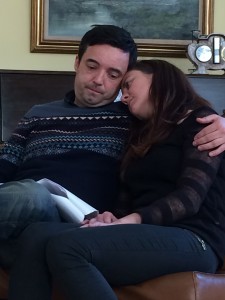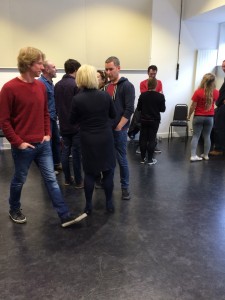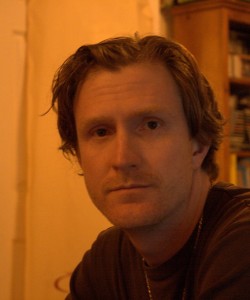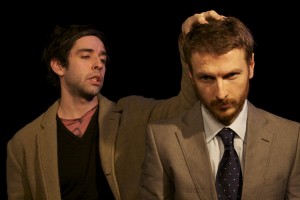What does David teach?
David’s technique begins with the teachings of Stanislavski, the first studio-style acting teacher, and branches into cutting edge, highly sophisticated, contemporary approaches to acting that give great depth and nuance to stage and film performance necessary for modern screen and stage work. These sophisticated levels of the work open up the creative powers of the actor, obliterate self-consciousness and present pathways to character portrayal that truly allow the character’s story to be told, connecting on intimate and visceral levels with the audience.
These are the skills evident in our finest A-list actors. David believes his job is to bring his actors to these levels and provide them with the tools to stay there.
1. Understanding Acting
Due to running battles through the 20th century between acting teachers and theorist over the “right” way to act, the beginner actor is confronted with a great deal of confusion about the definition of acting and what is expected of him/her. David has developed a precise system of enlightening the actor as to what acting is in a modern context, putting the arguments and diatribes of many practitioners into an easily understandable perspective.
David believes that the actor must be aware and knowledgable of the nature of his/her craft and the state of the art as it stands before the actor can begin to work on his/her individual approach to acting. As such, David introduces the Stanislavski System as a stepping-off point as it is Stanislavski’s ideas that have shaped western theatre, film and television for the past century. David then departs from Stanislavski, harkening back to previous popular forms of theatrical expression such as the Greek Theatre, Tribal ritual, Asian theatre, Commedia Del Arte, Shakespeare, Melodrama and Mime. David also instills in his actors an understanding of the reasons behind the 20th century departures from Stanislavski by practitioners such as Michael Chekhov, Ettiene Decroux and Antonin Artaud. He also examines extensions of Stanislavski’s ideas by Meisner and Adler and the Practical Aesthetics school of thought and analyses the fierce reactions against Stanislavski by practitioners such as Anne Bogart and David Mamet and why such individuals feel so passionately against Stanislavski’s body of influence, accusing him of fraud and the ruination of acting and theatre.
David takes no sides in these heated arguments and feels that such vicious battles only serve to confuse the emerging actor, however he also feels that the actor should understand the reasons for and nature of these arguments in order to find a clarity that will bolster the power of the individual artist within.
 2. Understanding Stanislavski.
2. Understanding Stanislavski.
As Meisner did, David has filtered the Stanislavski System through his own values and needs as an actor and teacher, simplifying and clarifying many controversial ideas so that the actor can use the tools free from the fear and mystery attached to them by later writers and theorists. David has done this work with many of Stanislavski’s ideas in order to clarify them for his students and render them practical and applicable.
To give a simple example: David teaches the notion of Emotion Memory not as something frightening and mysterious, but as a simple and natural human reaction to the world around us. Put simply, if a friend tells us their mother has died, we sympathise. What we don’t stop the think about is that we then leap naturally to empathy, a state in which we recall, either consciously or subconsciouly a moment in our life when we have felt the grief of the death of our own mother or a close relative in order to put ourselves in the shoes of of our friend, understand their feelings and help them in whatever way we can. We have used a process of Emotion Memory in order to help a friend. The process can make us sad, with the friend or for the friend. The process has naturally brought us closer to the friend’s true feelings and given us papable clues about how they might be feeling. How does this work in terms of Acting? We read a script. We find that a man, Hamlet, has lost his father. He does not yet know how or why, all we know is that he has lost his father. As soon as we understand his circumstances, we sympathise and then empathise with him, naturally calling upon our own experiences of loss. It’s as natural as the breeze. We do it without thinking.
From this point, David has developed pathway to what he describes as The Third Place. We travel naturally through sympathy and empathy, and there’s a third place that the actor then goes to in order to play the role. There is no word in the English language for this place, but again, that does not make it mysterious or ethereal. It is the process of art in which the actor becomes the subject. It is at this juncture that the actor ceases to represent the character and joins the character, essentially looking out of the character’s eyes, thinking his thoughts and feeling his feelings, not moving the character around the stage, but being moved by him. It is a similar sensation that the writer has when he is “on a roll” and the work seems to write itself. For the painter, the painting begins to emerge seemingly without him. He is no longer consiously following his technique. The technique is a whole and is purely supporting the creation of the work of art. And that is why it cannot fly out of control. It is anchored to a technique. It cannot become self-indulgent, because it is no longer about the actor.
Stanislavski refers to this place as the Threshold of the Subconscious and again it has been vilified because it cannot essentially be taught but can only be shown to the actor. In the same way that the teacher helps the student along a pathway to a door and can even open the door, it is the student who must step through it. This of course causes great frustration to any teacher of Stanislavski who has not developed a logical, step by step process to that place. Their reaction to it is that it must therefore must be “wrong” and doesn’t really exist.
Sympathy/Empathy/Third Place, is only one step by step process that David has developed to move the actor towards powerful acting of an artistic nature in keeping with the demands of realistic and naturalistic acting of a Stanislavskian type. However the realism of Stanislavski is only one form.
3. The Physical Actor and the Beautiful Stage
David also takes his actors into the world of the theatre and film event as image-based works of art and considers the actor as a physical form within that process. Utilising the techniques of Michael Chekhov’s higher-ego and radiation, the sensory imagery and physical presence of Decroux’s Corporeal Mime and practical applications of Proxemics and Kenesics, David instills in the actor an understanding of the body in space and within the archetecture of a specific theatre or set as a mounted work of art.
David’s own theoretical notion of the Beautiful Stage comes into play in this process. Essentially it defines the Stage as a frame or platform that is eternal due to the nature of gravity. In simple terms, we are all on a Stage, all the time. It is inescapable. It is the effect of being mounted and “Staged” that gives the subject (the actor) special presence and power in the theatre. It gives the subject Beauty in an artistic sense. David feels it is necessary for the actor to understand the power of the Stage beneath his/her feet and how it effects them as an entity when placed before an audience.
4. Idiosyncratic Transformation
David has developed a specific system of transforming the body physically into character. Although it sounds complex, Idiosyncratic Transformation is, in simple terms, a method of studying the idiosyncrasies and habits of the individual and systematically building a unique formation for a complete character. The system works on the premise that each individual human being has a unique idiosyncratic pattern. This pattern is as unique as a fingerprint. To discover the pattern of the character and transfer it to the actor’s body is an inspiring and wholly artistic endeavour that can lead the actor into a mind-opening understanding of what it is like to literally BE someone else. The result is a unique, living character with its own “sound”.
 Here David refers to the work of Richard Hayes-Marshall and his concept of Le Son du Closh (the sound of the bell). As no two bells sound exactly alike, no two human beings “sound” alike either. The actor and the character may look somewhat alike, but their “sound”, their essence, can never be.
Here David refers to the work of Richard Hayes-Marshall and his concept of Le Son du Closh (the sound of the bell). As no two bells sound exactly alike, no two human beings “sound” alike either. The actor and the character may look somewhat alike, but their “sound”, their essence, can never be.
Other technical tools include:
Emotion-Point Physical Reaction
Extended Imagery
Identification
Physical Entity
Third Place Theory (Sympathy, Empathy, Third Place)
Separation
Idiosyncratic Transformation
Beautiful Stage
Practical Proxemics and Kinesics
Multiple Objective Theory
Four Worlds
Archetype and Antithesis
Triangulation and Camera Relationship
5. Joining it all.
At the end of the training process, the technique is practiced and embodied and effectively “forgotten” leaving the actor with the wonderful feeling of complete immersion and total performance confidence.
The final result is perfection and excellence in performance.
E: scottdavidmichael@gmail.com for any questions or comments.

